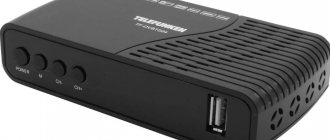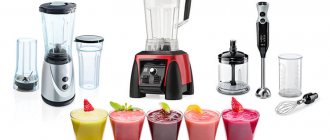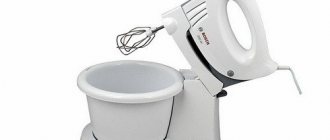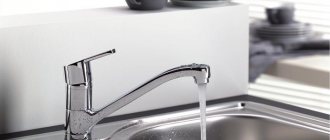The mixer helps you quickly prepare many dishes; it makes them tastier due to the uniform consistency of the products. Hand mixers and stand mixers are available for sale. They are designed to perform different tasks. A hand mixer is enough to beat an omelette or knead a semi-liquid dough. The device must be constantly held in your hands, it has little power, and the operating time is limited.
It is much more convenient to work with a stationary one. But they also come in different forms, simple or with planetary stirring. Let's consider which mixer is better to buy: planetary or stationary, how they are similar and what the difference is.
Let's vote which mixer is better to buy for your home
Planetary
68.18%
Stationary
31.82%
Voted: 22
What is the difference between a planetary mixer and a stationary mixer?
The main difference in the operation of conventional and planetary devices is in the trajectory of movement of the nozzles. With a stationary one, they simply rotate in a circle, whipping the products. In a planetary device, the nozzles rotate simultaneously in two directions, which makes it possible to obtain a homogeneous mass.
A regular tabletop can process a small amount of food. And the device with planetary mixing can perform operations regularly. It is much more powerful, the bowl volume is much larger.
Features of planetary mixer
Since the planetary mixer has axial mixing of products, the likelihood of complete and high-quality mixing of products increases significantly. This mixer is used both in everyday life and in industry. It is suitable for making dough. Due to the maneuverable movements of the nozzles, the dough is completely mixed, eliminating the formation of lumps in various places in the bowl. Also, due to its greater power, it can be used for preparing potato or fruit puree, cream, sauces, mousses, etc.
Advantages
The advantages of this type of electric mixer include the following:
- Multifunctionality. A wide range of possibilities allows you to use it in the preparation of various products.
- Many types of attachments. Unlike hand-held and stationary mixers, planetary mixers have a larger number of attachments. They may vary in size. Some models have multiple attachments.
- Various bowl volumes. For stationary mixers, the bowl volume varies from 3 to 7 liters, while for planetary mixers it can reach up to 120 liters. Most often, at home, volumes of up to seven liters are used, which already exceeds the usual dimensions for standard mixers.
- High power. The increased power allows you to use the device even for grinding solid masses and quickly preparing flour products.
Flaws
Despite their characteristics, planetary mixers have certain disadvantages:
- High price. Compared to conventional electric mixers, the price of this type of mixer can reach 100 thousand rubles, which can become a problem for purchasing it.
- High electricity consumption. Due to the high power consumption of electricity, this device is an order of magnitude higher than that of manual or stationary mixers.
- Big size. Due to the large volume of the bowl, the dimensions of this device can be quite large.
Subscribe to our Social networks
What is a planetary mixer
Externally, a planetary mixer is similar to a stationary one. It also consists of a body, a stand and a bowl in which food is placed. The main difference is in the trajectory of the nozzles. The principle of operation of a planetary mixer lies in its name. Just as the planets rotate around the Sun and at the same time around their own axis, so the nozzles of the device rotate around the axis and at the same time pass the bowl of food in a circle. This allows you to quickly and evenly mix ingredients, knead dough, or perform other operations.
Features of a stand mixer
A stand mixer is still the same device with a special bowl for food, a stand and a rotating motor with attachments. This device will ensure thorough mixing of products to a homogeneous consistency, suitable for preparing good dough, whipped cream or cottage cheese. Unlike a conventional mixer, you don’t have to hold this type in your hands, but, having set the right time and pace, use it effortlessly while doing something else.
Advantages
- Easy to use. Automated operation of the mixer will allow you to do other things.
- Bowl volume. As a rule, stationary mixers have a fairly large bowl, due to which splashing of the mass is practically eliminated.
- Large nozzles. Due to the large attachments, meat products can be chopped much better than with hand mixers.
- High power. Due to its high power, this type has greater functionality than hand mixers.
Flaws
- High price. Compared to hand mixers, purchasing a stationary appliance will cost more.
- Large dimensions. Unlike hand mixers, the size of stationary mixers differs several times.
What does a planetary mixer mean and how does it differ from a regular stationary mixer?
To understand the difference between devices, you first need to study their design. Units of both types consist of the following parts:
- housings with a motor, electronic control boards and buttons for setting;
- food bowls;
- replaceable rims and hooks installed in the upper part of the body.
When you turn on the device, its nozzle begins to move and automatically beats the dough or liquid ingredients placed in the bowl.
The general principle of operation is the same for all models - there are no differences here. But the difference between the devices lies in the trajectory of movement of the whipping attachment:
- In an ordinary apparatus, the whisk rotates around its own axis in one or two directions. The wide attachment effectively whips cream, cottage cheese, liquids or soft dough in the bowl, giving them a uniform consistency.
- The difference between the planetary device is that the whisk not only rotates around an axis, but also simultaneously moves around the internal space of the container in a circular motion. The trajectory resembles an orbital one, hence the name. Due to the difference in the rotation system, the maximum quality of whipping ingredients is achieved.
Important! Differences in capacity, power and functionality are determined not by the category of devices, but by the cost and class of individual models.
Many conventional mixers come with a lid that prevents splashing.
How to choose a planetary mixer for your home?
There are five objective criteria for choosing a particular model.
Material
It is worth mentioning right away that the material of the body and the material of the working bowl, where the ingredients are mixed, are considered separately.
In the production of cases, durable plastic or metal is used, most often painted or polished stainless steel. The plastic body is much lighter and cheaper to produce, which has become the reason for the widespread use of this material in budget models and mixers in the mid-price range. The advantage of plastic is weight. The device is easier to carry or move. However, this is also a disadvantage. Low weight increases vibration, which sometimes leads to a peculiar noise during operation at high speeds. In inexpensive models with a plastic case, foreign odors may appear.
Metal cases were used in the first models. Nowadays you can see them more often in premium mixers. Devices in a metal case are heavier, less prone to excessive vibrations, and are stable even at maximum speed. At the same time, the large mass makes transportation difficult.
Bowls are made of glass, plastic and metal. Each material has its own characteristics that should be taken into account when choosing.
- Plastic. Cheap and lightweight, but can crack during use. It is used most often in the most budget models.
- Glass. The most environmentally friendly material. High aesthetics and excellent hygiene. The disadvantage of glass bowls is their fragility. If you drop it on a tiled floor, you will most likely have to buy a new one.
- Metal. The most commonly used is polished or painted stainless steel. The most hygienic material. It makes ideal bowls for planetary mixers.
There are models with bowls from 1.5 to 6 liters. How to determine what volume you need? Everything is very simple. Assess what kind of meals you plan to cook and what size your typical portions are. Of course, if necessary, a good “planetary” will beat even one egg in a bowl of maximum volume, but this is irrational, and it’s simply more difficult to wash a large bowl.
As an example: to prepare a pizza weighing 800-1000 grams, a 3-liter bowl is enough. Just in case, it’s worth adding 20-30% to the maximum volume. The “average” model in terms of performance can easily be used to prepare a dish for one person without any discomfort.
Engine power
This indicator determines how stiff the dough the device can mix. In addition, power determines how quickly the mixture will be prepared. However, this same indicator also affects the price. The more powerful the model, the more expensive it costs the buyer. And its electricity consumption will be noticeably higher. For domestic use, a model with a 650W motor is sufficient, while mixers from 950W are more likely intended for semi-professional use.
Nozzles
Depending on the complete set, the device can be supplied with two or more attachments:
- Whisk. Used for whipping batters, mousses, omelettes and other “light” mixtures.
- Hook. The spiral attachment is used for kneading stiff dough that a whisk can no longer cope with. For example, we can talk about dough for pizza, dumplings or pasties.
- Pyureshnitsa. Very similar to a massage nozzle from a hair dryer. Allows you to prepare potato, vegetable, fruit or any other puree with the perfect texture without lumps.
- Spatula. Used for whipping airy creams or kneading shortbread dough.
- Knife. A disc or blade knife can be used to evenly cut vegetables into slices or discs (slices).
- Blender. Allows you to grind products, for example, for preparing baby food, smoothies, cocktails and so on.
The stand mixer can also be supplied with other attachments, for example for preparing pasta and spaghetti, sausages and sausages. However, this is more typical for high-level technology, approaching professional.
Modes
- Standard. Mixing products or whipping, depending on the speed of rotation of the nozzles.
- Pulse. Necessary if you plan to frequently grind hard products. The engine runs intermittently, which allows you to work, for example, with nuts with less effort and more safely.
- Turbo. Peak power and speed values. The engine starts in turbo mode for literally a few seconds, then operation is interrupted.
- Gradual increase in turnover. Good when working with liquid mixtures. Thus, the gradual start of rotation of the whisks will not allow the contents of the bowl to spill if it does not have a special lid with a hatch for adding products.
Rating of planetary mixers
The design of a planetary mixer differs from conventional models. The mixing tool moves inside the container by analogy with the movement of the planets - immediately around the axis and the dough bowl. The device is not very fast, but it is designed for a significant volume of mixture, which must be taken into account when deciding which planetary mixer to choose for your home. When compiling the review, the characteristics of the equipment and expert opinions were taken into account. The rating of the best planetary mixers was prepared taking into account the following parameters:
- Tasks. Additional options do not affect the result;
- Power. For domestic use, 700-1100 W is enough;
- Material. The elements are made from polymer materials and plastic of special strength, as they relate to products;
- Bowl. The optimal volume is 2-4 or 4-6 liters. Plastic is saturated with fats, so the best option is a stainless steel container;
- Whipping speed. Each model has its own meaning;
- Nozzles The equipment should be equipped with a spatula, a functional dough hook and a convenient whisk;
- Safety. Heat protection ensures long service life. The best models are made from stainless steel, but they will cost more.
To buy a planetary mixer inexpensively, you can also look at plastic devices. During the selection, attention was also paid to price-quality ratio, commercial availability, effectiveness, ease of use and versatility.
Space Force to the rescue
What is planetary mixing and where did such a “cosmic” name come from? A school astronomy course will help answer this question. Remember how the solar system works. All the planets in it rotate around their own axis and at the same time move in orbits around the Sun. The same principle underlies the planetary mixing of the KENWOOD kitchen machine. The nozzle, installed in a special socket, rotates around an axis, simultaneously describing a circle inside the bowl with the ingredients.
Planetary mixing has a number of undeniable advantages over conventional mixing. Since it happens automatically, you do not need to hold the device or control the process. But the most important thing is that, rotating in a special mode, the nozzle picks up the mixture of ingredients from the bottom and walls of the bowl, thereby ensuring perfect mixing. It is impossible to achieve such impressive results with a hand mixer.
The KENWOOD kitchen machine comes with planetary mixing attachments. The universal K-shaped attachment is designed for perfect pancake, sponge, yeast, shortbread and choux pastry. The hook attachment kneads soft, elastic and strong dough. It is indispensable for making dumplings, dumplings, pasta, homemade bread and other baked goods. The elastic metal whisk in the shape of a ball perfectly whips weightless and incredibly stable creams from cream and egg whites. This is an extremely important property. Indeed, in many recipes the whites need to be beaten in one direction, otherwise they will fall off after a while.
In addition to the main nozzles, you can additionally purchase two more nozzles for planetary mixing. The soft mix attachment glides smoothly along the edges of the bowl, collecting every last drop of ingredients from the sides and bottom and mixing amazingly smooth creams. The unique aeration attachment delicately whips up the most delicate mousses and soufflés. By saturating them with oxygen, it allows you to achieve a fluffy and strong consistency.
What it is?
The device received this name due to the similarity of the rotation trajectory of the corolla with the movement of planets around their axis. Thanks to this technique, a planetary device whips ingredients much more efficiently than a manual one. In addition, the unit copes with the kneading process independently, without requiring physical effort, which is very convenient. While your dough mixer is preparing mousse or puree, you can perform other tasks.
This device differs from a hand mixer not only in its operating principle, but also in appearance. A planetary mixer is a fairly massive structure that requires a certain amount of space in the kitchen. It consists of three main parts - the body, the bowl and the nozzle. The body, made of metal or plastic, weighs from 5 to 10 kg. Its upper part with the attached nozzle can be tilted to the required degree. The bowl, the so-called mixer bowl, with a volume of 3 to 5 liters, is located on the base of the body.
Previously, a large device with a planetary mixing system was used only in restaurants and cafes, where it was necessary to mix a large number of products at once. Nowadays, compact planetary mixers for home use are becoming increasingly widespread and are in demand among lovers of desserts and baked goods.
What is the difference between a planetary mixer with a bowl and a stationary one?
The planetary model is a universal device that makes it possible to cope with culinary tasks of any complexity.
A planetary mixer can easily be called a universal device that allows you to perform several tasks during the cooking process.
A basic overview of the differences between planetary mixers and stationary mixers is as follows:
- Direction of movement of the corolla. The nozzle of the planetary mixer moves simultaneously in two trajectories - around its own axis and in the opposite direction, which gives high whipping efficiency. When mixed, a completely homogeneous dough is obtained.
- Multifunctional use. The planetary model can be successfully used for grinding and homogenizing hard products: preparing minced meat and pates from meat, grinding grain if necessary, etc. A wide variety of attachments are available for these functions.
- Planetary units have a maximum range of speeds - up to 10 types. This makes it possible to professionally regulate the process properly and quickly achieve the desired results.
- In industrial models, the bowl volume of planetary devices can reach 150 liters. These samples are equipped with automatic lifts and the ability to select work programs.
Modern planetary mixers can handle even hard products.











